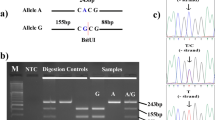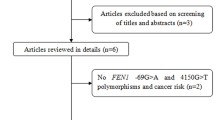Abstract
This study aimed to investigate whether the genetic variants of CRTC1, BARX1, FOXP1 and FOXF1 are associated with the development of oesophageal adenocarcinoma (OA) in Chinese population. A total of 744 OA patients and 1138 controls were included in this study. Here we genotyped four SNPs, rs10419226 of CRTC1, rs11789015 of BARX1, rs2687201 of FOXP1 and rs3111601 of FOXF1. The chi-square test was used to compare the genotype and allele frequencies between the patients and controls. The student’s t-test was used to compare FOXP1 expression in the tumour and the adjacent normal tissues. The relationship between genotypes of rs2687201 and FOXP1 expression was investigated by one-way analysis of variance test. Patients were found to have significantly higher frequency of allele A of rs2687201 and allele C of rs3111601 when compared with the controls (49.2 vs 43.4%, \(P = 0.0008\) for rs2687201; 29.1 vs 24.0%, \(P = 0.0003\) for rs3111601). There was a significantly higher expression level of FOXP1 in the tumour than in the adjacent normal tissue (0.0052 ± 0.0021 vs 0.0027 ± 0.0018, \(P < 0.001\)). Patients with genotype AA were found to have remarkably higher FOXP1 expression in the tumour than those with genotype CC (\(P = 0.01\)). To conclude, the varients of FOXP1 and FOXF1 genes are functionally associated with OA in Chinese population. With the identification of more susceptible loci, the combined effect of these markers may be helpful for the surveillance of OA.

Similar content being viewed by others
References
Aken B. L., Ayling S., Barrell D., Clarke L., Curwen V., Fairley S. et al. 2016 The Ensembl gene annotation system. Database (Oxford).
Babar M., Ryan A. W., Anderson L. A., Segurado R., Turner G., Murray L. J. et al. 2012 Genes of the interleukin-18 pathway are associated with susceptibility to Barrett’s esophagus and esophageal adenocarcinoma. Am. J. Gastroenterol. 107, 1331–1341.
Becker J., May A., Gerges C., Anders M., Veits L., Weise K. et al. 2015 Supportive evidence for FOXP1, BARX1, and FOXF1 as genetic risk loci for the development of esophageal adenocarcinoma. Cancer Med. 4, 1700–1704.
Buas M. F., Levine D. M., Makar K. W., Utsugi H., Onstad L., Li X. et al. 2014 Integrative post-genome-wide association analysis of CDKN2A and TP53 SNPs and risk of esophageal adenocarcinoma. Carcinogenesis 35, 2740–2747.
Consortium G. T. 2015 Human genomics. The Genotype-Tissue Expression (GTEx) pilot analysis: multitissue gene regulation in humans. Science 348, 648–660.
Dai J. Y., de Dieu Tapsoba J., Buas M. F., Onstad L. E., Levine D. M., Risch H. A. et al. 2015 A newly identified susceptibility locus near FOXP1 modifies the association of gastroesophageal reflux with Barrett’s esophagus. Cancer Epidemiol. Biomarkers Prev. 24, 1739–1747.
Doecke J., Zhao Z. Z., Pandeya N., Sadeghi S., Stark M., Green A. C. et al. 2008 Polymorphisms in MGMT and DNA repair genes and the risk of esophageal adenocarcinoma. Int. J. Cancer 123, 174–180.
Dura P., van Veen E. M., Salomon J., te Morsche R. H., Roelofs H. M., Kristinsson J. O. et al. 2013 Barrett associated MHC and FOXF1 variants also increase esophageal carcinoma risk. Int. J. Cancer 133, 1751–1755.
Engel L. S., Chow W. H., Vaughan T. L., Gammon M. D., Risch H. A., Stanford J. L. et al. 2003 Population attributable risks of esophageal and gastric cancers. J. Natl. Cancer Inst. 95, 1404–1413.
Freedman N. D., Abnet C. C., Leitzmann M. F., Mouw T., Subar A. F., Hollenbeck A. R. et al. 2007 A prospective study of tobacco, alcohol, and the risk of esophageal and gastric cancer subtypes. Am. J. Epidemiol. 165, 1424–1433.
Hur C., Miller M., Kong C. Y., Dowling E. C., Nattinger K. J., Dunn M. et al. 2013 Trends in esophageal adenocarcinoma incidence and mortality. Cancer 119, 1149–1158.
Kong C. Y., Kroep S., Curtius K., Hazelton W. D., Jeon J., Meza R. et al. 2014 Exploring the recent trend in esophageal adenocarcinoma incidence and mortality using comparative simulation modeling. Cancer Epidemiol. Biomarkers Prev. 23, 997–1006.
Koon H. B., Ippolito G. C., Banham A. H. and Tucker P. W. 2007 FOXP1: a potential therapeutic target in cancer. Expert Opin. Ther. Targets 11, 955–965.
Lanuti M., Liu G., Goodwin J. M., Zhai R., Fuchs B. C., Asomaning K. et al. 2008 A functional epidermal growth factor (EGF) polymorphism, EGF serum levels, and esophageal adenocarcinoma risk and outcome. Clin. Cancer Res. 14, 3216–3222.
Levine D. M., Ek W. E., Zhang R., Liu X., Onstad L., Sather C. et al. 2013 A genome-wide association study identifies new susceptibility loci for esophageal adenocarcinoma and Barrett’s esophagus. Nat. Genet. 45, 1487–1493.
Menke V., van Zoest K. P., Moons L. M., Hansen B., Pot R. G., Siersema P. D. et al. 2012 NcoI TNF-beta gene polymorphism and TNF expression are associated with an increased risk of developing Barrett’s esophagus and esophageal adenocarcinoma. Scand. J. Gastroenterol. 47, 378–386.
Navab F., Nathanson B. H. and Desilets D. J. 2015 The impact of lifestyle on Barrett’s esophagus: a precursor to esophageal adenocarcinoma. Cancer Epidemiol. 39, 885–891.
Qiao Y., Hyder A., Bae S. J., Zarin W., O’Neill T. J., Marcon N. E. et al. 2015 Surveillance in patients with Barrett’s esophagus for early detection of esophageal sdenocarcinoma: a systematic review and meta-analysis. Clin. Transl. Gastroenterol. 6, e131.
Rice T. W., Blackstone E. H. and Rusch V. W. 2010 7th edition of the AJCC cancer staging manual: esophagus and esophagogastric junction. Ann. Surg. Oncol. 17, 1721–1724.
Sampliner R. E. 2005 Epidemiology, pathophysiology, and treatment of Barrett’s esophagus: reducing mortality from esophageal adenocarcinoma. Med. Clin. North Am. 89, 293–312.
Sappati Biyyani R. S., Chessler L., McCain E., Nelson K., Fahmy N. and King J. 2007 Familial trends of inheritance in gastro esophageal reflux disease, Barrett’s esophagus and Barrett’s adenocarcinoma: 20 families. Dis. Esophagus. 20, 53–57.
Shu W., Lu M. M., Zhang Y., Tucker P. W., Zhou D. and Morrisey E. E. 2007 Foxp2 and Foxp1 cooperatively regulate lung and esophagus development. Development 134, 1991–2000.
Su Z., Gay L. J., Strange A., Palles C., Band G., Whiteman D. C. et al. 2012 Common variants at the MHC locus and at chromosome 16q24.1 predispose to Barrett’s esophagus. Nat. Genet. 44, 1131–1136.
Trudgill N. 2002 Familial factors in the etiology of gastroesophageal reflux disease, Barrett’s esophagus, and esophageal adenocarcinoma. Chest Surg. Clin. N. Am. 12, 15–24.
van Nistelrooij A. M., van der Korput H. A., Broer L., van Marion R., van Berge Henegouwen M. I., van Noesel C. J. et al. 2015 Single nucleotide polymorphisms in CRTC1 and BARX1 are associated with esophageal adenocarcinoma. J. Carcinog. 14, 5.
Wlodarska I., Veyt E., De Paepe P., Vandenberghe P., Nooijen P., Theate I. et al. 2005 FOXP1, a gene highly expressed in a subset of diffuse large B-cell lymphoma, is recurrently targeted by genomic aberrations. Leukemia 19, 1299–1305.
Wolf W. A., Pasricha S., Cotton C., Li N., Triadafilopoulos G., Muthusamy V. R. et al. 2015 Incidence of esophageal adenocarcinoma and causes of mortality after radiofrequency ablation of Barrett’s esophagus. Gastroenterology 149, 1752–1761.
Zhang Y., Zhang S., Wang X., Liu J., Yang L., He S. et al. 2012 Prognostic significance of FOXP1 as an oncogene in hepatocellular carcinoma. J. Clin. Pathol. 65, 528–533.
Acknowledgements
We sincerely thank Dr Haozhong Hu for his assistance in the proof reading of our manuscript.
Author information
Authors and Affiliations
Corresponding author
Additional information
Corresponding editor: Dhavendra Kumar
Jie Zhang and Jiebin Chen contributed equally to this work.
Rights and permissions
About this article
Cite this article
Zhang, J., Chen, J., Ma, T. et al. Genetic variants of FOXP1 and FOXF1 are associated with the susceptibility of oesophageal adenocarcinoma in Chinese population. J Genet 97, 213–218 (2018). https://doi.org/10.1007/s12041-018-0910-3
Received:
Revised:
Accepted:
Published:
Issue Date:
DOI: https://doi.org/10.1007/s12041-018-0910-3




